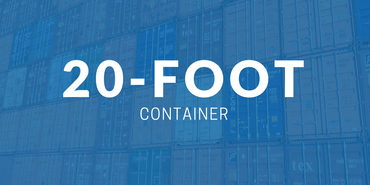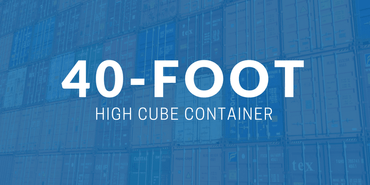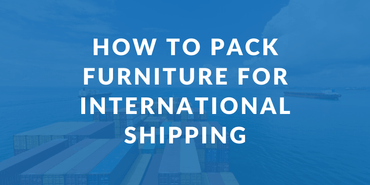
40-foot Container - Dimensions, Measurements and Weight



1. Dimension & Capacity of 40-ft Container
| Metric | Exterior | Interior (usable) | Why it matters |
|---|---|---|---|
| Length | 12.19 m / 40 ft | 12.03 m / 39 ft 6 in | Load‐planning & dunnage |
| Width | 2.44 m / 8 ft | 2.35 m / 7 ft 9 in | Pallet optimisation |
| Height | 2.59 m / 8 ft 6 in | 2.39 m / 7 ft 10 in | Stack height checks |
| Usable volume | – | ≈ 67 m³ (2,366 ft³) | CBM calculator inputs |
| Tare weight | – | ≈ 3,700 kg | Net vs. gross declarations |
| Max gross | – | ≈ 32,500 kg | Carrier / road limits |
Figures based on Maersk’s 2025 equipment spec sheet and ISO 668 ratings (wikipedia)
2. How Many Pallets Fit in a 40-ft Container?
- Euro pallets (1.20 m × 0.80 m): 24‑25 when arranged tightly on the floor.
- US standard pallets 40 × 48 in: Typically 20–21 per layer.
Exact counts hinge on pallet overhang, carton height, and weight distribution. (iContainers)
Tip: For mixed SKUs, try a pallet‑wide 40‑ft box (non‑ISO but common in Europe) – it squeezes in 30 Euro pallets floor‑loaded.
3. Typical 40‑ft Cargo Profiles
| Commodity | Why the 40‑ft works |
|---|---|
| Furniture & household goods | Fills cube before hitting weight limits; perfect for international movers |
| Electronics & retail stock | Cartonised loads maximise floor space and CBM‑rate savings |
| Automotive parts / machinery | Dense but not overly heavy; easy fork‑lift loading |
| Reefer perishables (fruits, seafood) | 40‑ft high‐cube reefers offer 12 cm extra headroom & 76 m³ volume (wikipedia) |
4. Weight Limits & Safety
- Tare: ~ 3.7 t
- Carrier max gross: 32.5 t (varies slightly by line).(wikipedia)
- Typical road cap: 36 t gross for truck + container in many EU countries.
Always check both sea leg and inland rules; exceeding axle limits can trigger hefty fines or require special permits.
5. Freight Cost Drivers You’ll See on the Invoice
| Cost Lever | What It Covers | When It Spikes |
|---|---|---|
| Base ocean freight | Port‑to‑port movement | Busy lanes or equipment shortages |
| BAF – Fuel Adjustment Factor | Bunker price volatility | Tariffs set quarterly; next revision 01 Jan 2025 maersk.com |
| CAF – Currency Adjustment Factor | FX fluctuation buffer | Long USD‑linked routes |
| Port & Terminal Handling (THC, T3) | Crane, gate & wharf fees | Annual update e.g., Rotterdam 2025 tariff Port of Rotterdam |
| Special surcharges | Piracy, canal transit, congestion | Suez/Panama diversions; peak‑season PSS |
6. Seasonal Volatility & Booking Windows
| Period | Market Behavior | Smart Shipper Move |
|---|---|---|
| Jul – Nov (Peak) | Retail stocking drives capacity crunch; PSS applies | Book 4–6 weeks ahead |
| Chinese New Year (Jan/Feb) | Pre‑holiday factory sprint; post‑holiday lull | Ship early or wait out the spike |
| Golden Week (Oct) | Short, sharp Asia congestion | Secure equipment two sailings in advance |
7. FCL vs. LCL – The 40‑ft Edition
- FCL 40 ft shines once your load hits 50 m³ or > 18 t – the per‑CBM rate plunges and you control the seal.
- LCL makes sense for scattered cartons under ~ 15 m³; just budget for consolidation and devanning fees.
Use our CBM calculator; if utilisation is < 60 %, get an LCL quote too.
8. Packing Your 40‑ft Container for Success
- ISPM‑15 pallets/crates – universal customs acceptance.
- Shrink‑wrap + desiccants – fight sea‑borne moisture.
- Weight balance – alternate heavy/light stacks along the length.
- Ratchet straps & airbags – stop cargo shift on heavy seas.
- IMDG‑compliant labelling for haz‑mat loads (see IMO IMDG Code). (UMO)
9. Why SMEs & Corporates Alike Love 40‑Footers
- Economies of scale: Lower $ / CBM than two 20‑footers.
- Versatility: Dry, high‑cube, reefer, open‑top and flat‑rack variants.
- Global compatibility: Port cranes, chassis, rail wagons built around 40‑ft footprint.
Frequently Asked Questions
Yes—ISO units are Wind & Water Tight, but condensation can still form; always add desiccants.
Yes—if they meet the IMDG Code and you supply the MSDS, UN number and correct placards, plus carrier pre‑approval. (UMO)
Floor‑loaded, you can usually fit 24–25 Euro pallets; pallet‑wide containers (non‑ISO) can take up to 30. (iContainers)
- 1. Dimension & Capacity of 40-ft Container
- 2. How Many Pallets Fit in a 40-ft Container?
- 3. Typical 40‑ft Cargo Profiles
- 4. Weight Limits & Safety
- 5. Freight Cost Drivers You’ll See on the Invoice
- 6. Seasonal Volatility & Booking Windows
- 7. FCL vs. LCL – The 40‑ft Edition
- 8. Packing Your 40‑ft Container for Success
- 9. Why SMEs & Corporates Alike Love 40‑Footers
Related Articles


